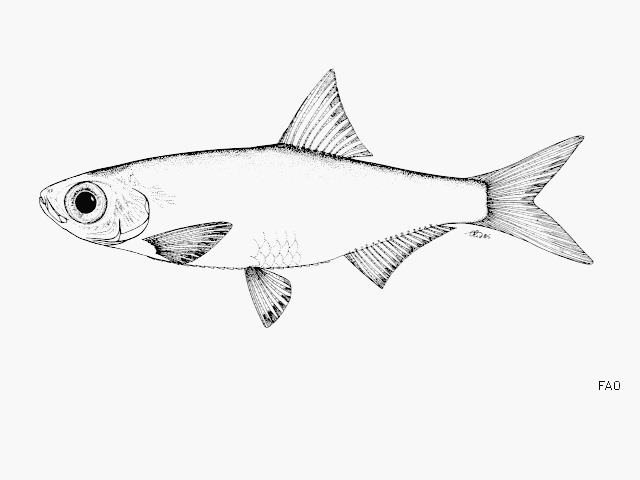|
Dorsal spines (total): 0-0; Dorsal soft rays (total): 12-15; Anal spines: 0-0; Anal soft rays: 18-21; Vertebrae: 40-44. Diagnosis: Body moderately deep, its depth about 22-30% of standard length; scutes strongly keeled, 1 or 2 before base of first pectoral fin ray, 11-12 pre-pelvic and 6-8 post-pelvic scutes; snout pointed; lower jaw not or slightly projecting, included in upper when mouth closed, with small teeth limited to anterior part; pre-maxilla with 12-30 small conical teeth directed inwards; maxilla blade slender, more than 3 times as long as deep, upper edge with a ridge flared outward; posterior supra-maxilla small, spatulate, shaft as long as blade; lower gillrakers 18-22 (Ref. 188, 47399, 93833). Also characterized by 37-43 scales in a longitudinal series and anal fin with 18-21 rays (Ref. 47399). It resembles Microthrissa royauxi, which has fewer gillrakers but more anal fin rays, 14-17 and 23-27 respectively (Ref. 188). It is distinguished from Microthrissa whiteheadi by a lower number of teeth on the pre-maxilla, 12-30 vs. 32-40 in M. whiteheadi; and additionally by a higher number of lower gillrakers, 18-22 vs. 14-18, a lower number of anal fin rays, 18-21 vs. 20-25, and a lower number of pre-pelvic scutes, 11-12 vs. 13-16 (Ref. 46514, 47399).
Description: Body depth 21.7-30.0% of standard length; head length 11.1-12.7% of standard length (Ref. 188, 93833). Lower jaw not or slightly projecting; premaxilla with 12-30 conical teeth directed inwards; maxillary with 10-25 small conical teeth (Ref. 47399, 93833). First gill arch with 18-22 gillrakers on lower limb, 27-32 total gillrakers (Ref. 47399). Dorsal fin origin closer to snout than caudal fin base, inserted behind pelvic fin base; dorsal fin with 12-15 fin rays; anal fin with 18-21 fin rays; pectoral fin with 10-13 fin rays; pelvic fin with 1 unbranched and 6-7 branched rays (Ref. 47399, 93833). Cycloid scales; 37-43 on longitudinal line (Ref. 188, 47399). Scutes strongly keeled; 11-12 pre-pelvic scutes, with 1-2 scutes without ascending arms before base of pectoral fin, other 10 pre-pelvic scutes with ascending arms; 1 subpelvic scute without ascending arms; 6-8 post-pelvic scutes with ascending arms (Ref. 188, 93833). Number of vertebrae 40-44; with 20-23 abdominal vertebrae and 19-22 caudal vertebrae (Ref. 47399).
Colouration: Colouration of preserved specimens yellow greyish, occiput blackish by presence of numeral melanophores; a weak pigmented trace on caudal peduncle ending in a small black spot at base of lower lobe of caudal fin (Ref. 47399, 93833). |

